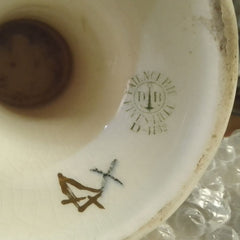De Bruyn Fives Lille

The story of the majolica of Fives-Lille starts with Antione Gustave De Bruyn, a fourth generation potter who left Belgium in 1864 and moved to Fives-Lille, a community in the northern part of France.
He started by building his own factory for production of clay pipes and whistles. Soon he expanded to include earthenware and stoneware for daily use. In 1887 the company catalogs included Art pottery and the newly popular Majolica. Majolica soon became a favourite choice for humidors, jardinières, vases and umbrella stands. The company' won a silver medal at the Universal Exhibition in Paris in 1889.The company soon employed more than 300 locals, production included majolica, sanitary wares and art pottery. Their sucess drew the attention of famous French designers such as Louis Majorelle and Rene lalique who both collaborated with the comoany. In 1917 a dvastating fire and the onset of WW I cut short the companys success.
Back in production after the war by the mid 1920's the company enjoyed success with Art Deco pottery and ceramic clocks until the early 1930's when economic and political factors in Europe shut down the factory. The factory opened again after World War II, it was sold in 1950 and resumed limited production until 1962 when the company was finlly dissolved.The De Bruyn Fives design of their whimsical animal pitchers and Art Nouveau flower themed wares remain their most popular work with collectors.

this mark circa 1900
The company marked their wares with both impressed marks and ink marks but always in a variation of an anchor with the De Bruyn initials.

Leave a comment